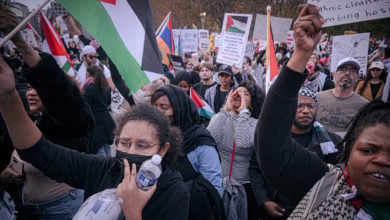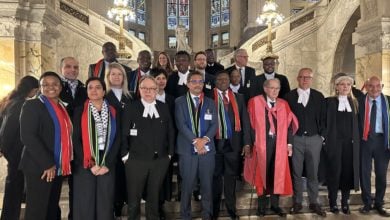Feb. 11 marked the 31st anniversary of the revolution of Iran. It was on this day in 1979 when the revolutionary movement finally succeeded in overthrowing the shah, who had ruled Iran for over a quarter century following the CIA coup of 1953.
 BBC reporter suggested turnout was small. |
The revolution signaled a complete change in the balance of power in the Middle East. The dictatorship of the shah, what President Carter boasted of being the “island of stability,” now gave way to an independent state that has since been an obstacle to U.S. designs on controlling the entire oil-rich region. In the absence of a strong left that could give the revolution working-class leadership, bourgeois-national religious forces have maintained capitalist relations while leading development along a path independent from imperialist plunder and domination.
For the last 31 years, U.S. imperialism has tried a variety of tactics to reverse the gains of this revolution, and to bring back the days when Iran was a U.S. client state, an ally of Israel, and the gendarme of the region on behalf of the Pentagon.
Every year, the anniversary of the revolution is a holiday celebrated by large numbers of Iranians. But the 31st anniversary had particular significance. The June 2009 presidential elections had brought large numbers of people to the streets demonstrating against Ahmadinejad’s election as president. The largest demonstrations happened in the week following the elections, when hundreds of thousands—possibly millions—marched in the streets of Tehran and a few other cities. In the months following the elections, much smaller but still significant demonstrations had occurred, the last on the Shi’a holy day of Ashura.
Extravagant predictions
Various opposition figures, including defeated presidential candidates Mir Hossein Moussavi and Mahdi Karroubi, had called for their supporters to come out to the streets and convert the anniversary marches into a show of force by the opposition. Some opposition figures made extravagant predictions, estimating that 3 million or more of their supporters would pour into the streets. This was going to be the day when, in the words of Mohsen Sazegara, an opposition figure, the foundation would be laid for a “final action.”
Imperialist media outlets played up the hype. Voice of America and BBC Farsi, broadcast into Iran through satellite TV, created an aura of a revolution in the making. On its online news site, CNN set up a format to report developments of the 31st anniversary on an hourly basis, anticipating significant opposition demonstrations to report on.
Well, millions of people did come out to the streets, but from the perspective of the opposition “greens” and their imperialist supporters, it was the wrong crowd. The outpouring of support for the revolution was huge, and that did more to quell the opposition’s drive for mounting a big march than the repression of the police and the Basiji militia. One protester told the Associated Press that she left in disappointment shortly after she and others tried to join opposition demonstrations, because they were overwhelmed: “There were 300 of us, maximum 500. Against 10,000 people.”
Western news media went out of their way to make light of the march of millions in support of the revolution and magnified the few hundred opposition demonstrators as the main newsworthy item. A BBC reporter actually said that Iranian media had not shown helicopter shots of the demonstrations, suggesting that the turnout must have been small. But a few hours later, helicopter shots were widely circulated on the Internet, showing a crowd of millions stretching for several miles and crowding Azadi Square, a huge area.
The initial denials eventually gave way to intense debates in pro-opposition blogs over the causes of the defeat. “I think a failure has triggered debates and tactical analyses that have been needed for a long time now,” said a 26-year-old opposition supporter in Tehran. On Feb. 15, the New York Times reported an entry on a popular Iranian opposition blog that asked: “Where were the Greens of Tehran? 1. On the Internet reading about the Trojan horse plan; 2. On YouTube learning about the ‘action’; 3. Chatting online in the afternoon about where to meet in the morning.”
Class composition of opposition demonstrators
This entry is an indication of the class composition of the demonstrators and their supporters, heavily composed of the upper middle class, the typical human material for U.S.-sponsored “color” revolutions. This is why this movement has often been referred to as the “Twitter Revolution.” In contrast, those who demonstrated for the revolution were overwhelmingly poor and working-class people, with far less access to blogs, the Internet and satellite TV.
Since the June 2009 elections, seemingly unaware of the long-standing U.S. goal of regime change in Iran, many liberal and progressive forces in the United States have supported opposition actions in support of the “people of Iran.” But the people of Iran have been heavily divided on the issue of the presidential elections, and a significant part of the people, actually the majority, voted for Ahmadinejad and continue to support the revolution. They refuse to endorse the political line of the “green” movement, a movement that has attempted to turn the energies of the masses away from hostility to U.S. imperialism and Israel, and instead direct their anger against the peoples of Palestine and Lebanon. This is clearly exposed by the opposition’s often chanted slogan: “Not Gaza, Not Lebanon, I give my life for Iran.” For a detailed analysis of the class character of the opposition movement, see “A class analysis of the crisis in Iran.”
Obama administration steps up drive for more sanctions
Over the last few months, the U.S. government and its ruling-class think tanks have begun to come to terms with the fact that their desired counter-revolution, the green revolution, was a dream. While their publicly declared dollars in support of “democracy” continues to be channeled towards forces fomenting instability and unrest, the Obama administration has ratcheted up its drive for getting another round of sanctions approved by the United Nations Security Council. This drive, and the propaganda campaign, has intensified after their hopes of a significant opposition showing on the 31st anniversary were dashed.
On Feb. 15, on a trip to Dubai and Saudi Arabia for the primary purpose of shoring up support against Iran among the U.S. client states of the region, Secretary of State Hillary Clinton declared: “Iran is moving towards a military dictatorship. ” No such words came out of Washington when Iran was a real military dictatorship under the shah. Nor did she make any such statements about the very countries in which she was making these statements, Dubai and Saudi Arabia, corrupt and ruthless dictatorships in which no elections have ever taken place.
In a Feb. 17 interview with National Public Radio, Clinton stated: “We want not only a world free of nuclear weapons; we want a Middle East free of nuclear weapons, including everyone.” It is only thanks to a compliant media—an integral part of the ruling class—that Clinton and other officials can go unchallenged after making such comical statements. If the U.S. government really wanted a “world free of nuclear weapons,” it would start at home where there are 10,000 nuclear warheads. If “a Middle East free of nuclear weapons” is Washington’s real goal, it would start with the one country in the region that actually has nuclear weapons: Israel.
But whether supporting the “democratic” opposition, condemning human rights violations, defending women’s rights or warning of the dangers of Iran’s non-existent nuclear weapons program, Washington has consistently pursued the same goal for the last 31 years: reversing the revolution of 1979 and bringing Iran back under U.S. control.
The people of Iran, along with the people of Palestine and Iraq and other peoples in the region, have proved that the U.S. drive to redraw the map of the Middle East will continue to meet strong popular resistance.






